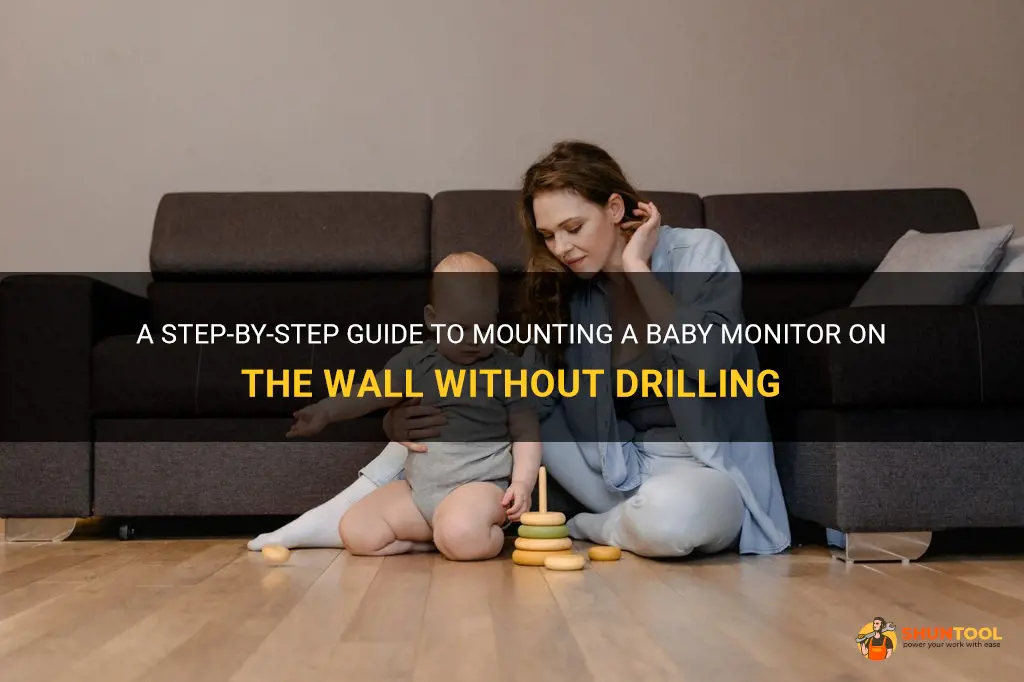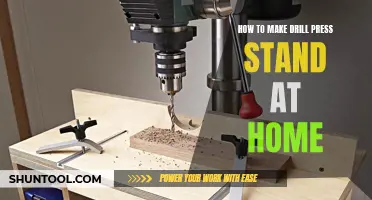
Have you recently become a proud parent or are you expecting a little bundle of joy? If so, one thing you might be considering is purchasing a baby monitor to help you keep an eye on your little one. However, the thought of drilling holes into your walls might be deterring you from taking the plunge. Well, fear not! In this article, we will guide you on how to mount a baby monitor on the wall without drilling, so you can keep a watchful eye on your baby without any damage to your walls.
What You'll Learn
- What are some alternative methods to mounting a baby monitor on the wall without drilling?
- Are there any adhesive options available for mounting a baby monitor on the wall without drilling?
- Can a baby monitor be mounted on a wall using a removable wall hook or command strips?
- Are there any wall mounting brackets specifically designed for baby monitors that don't require drilling?
- What are the potential risks or drawbacks of mounting a baby monitor on the wall without drilling?

What are some alternative methods to mounting a baby monitor on the wall without drilling?
When it comes to baby monitors, many parents prefer to mount them on the wall for better visibility and safety. However, drilling holes in the wall can be a hassle, especially if you're renting or have a fear of damaging the walls. Fortunately, there are several alternative methods to mount a baby monitor without drilling. Here are some ideas to consider:
- Command Strips: Command Strips are handy adhesive strips that can hold up lightweight objects without damaging the walls. To mount your baby monitor using Command Strips, attach the strips to the back of the monitor and press them firmly against the wall. Make sure to follow the manufacturer's instructions for weight limits and surface compatibility.
- Self-Adhesive Hooks: Similar to Command Strips, self-adhesive hooks can be used to hang your baby monitor. Choose hooks that can support the weight of your monitor and apply them to a clean and dry area on the wall. Press the hooks firmly onto the surface and give them some time to adhere before hanging the monitor.
- Wall-Mounting Brackets: Some baby monitors come with wall-mounting brackets specifically designed for easy installation. These brackets often require minimal hardware, like screws or nails, to secure them to the wall. Follow the instructions provided with your baby monitor to properly install the bracket and attach the monitor. Make sure to choose a suitable location on the wall away from potential hazards like cords or other objects.
- Adjustable Tripod Stand: If you prefer not to mount your baby monitor on the wall, an adjustable tripod stand can be a great alternative. These stands allow you to position the monitor at different heights and angles, providing you with optimal viewing without the need for drilling. Simply place the stand in a stable location near your baby's crib or play area and adjust the monitor to your desired position.
- Furniture Top: Another option is to simply place the baby monitor on top of a stable piece of furniture near your baby's sleeping or playing area. Ensure that the furniture is secure and won't be easily knocked over by children or pets. This method allows for quick and easy repositioning of the monitor as needed.
Remember to test the stability and safety of any alternative mounting method before leaving your baby unattended. Be cautious of potential hazards such as cords, electrical outlets, or objects that could be within reach of the baby. Always follow the manufacturer's instructions and guidelines for your specific baby monitor to ensure proper installation and usage.
In conclusion, mounting a baby monitor on the wall without drilling is possible with alternative methods such as Command Strips, self-adhesive hooks, wall-mounting brackets, adjustable tripod stands, or placing the monitor on top of furniture. Choose the method that is most suitable for your needs while ensuring the safety of your baby and a clear view of their surroundings.
Why Hammer Drills Are More Affordable Than Regular Drills: Exploring the Cost Differences
You may want to see also

Are there any adhesive options available for mounting a baby monitor on the wall without drilling?
Are you looking for a way to mount your baby monitor on the wall without drilling? There are several adhesive options available that can securely hold your baby monitor in place without the need for any drilling or permanent installation. In this article, we will explore some of these options to help you find the best solution for your needs.
One popular adhesive option for mounting a baby monitor is using heavy-duty mounting tape. This tape is specifically designed to provide a strong and secure bond between two surfaces. To use this method, simply cut a small piece of the mounting tape and attach it to the back of your baby monitor. Then, remove the protective film from the tape and press the monitor firmly against the wall in the desired location. Hold it in place for a few seconds to allow the tape to adhere properly. This adhesive method works well on smooth surfaces such as painted walls or tiles.
Another adhesive option to consider is using removable wall hooks. These hooks come with adhesive backing and can be easily attached to the wall without causing any damage. To mount your baby monitor using removable wall hooks, attach the hooks to the wall in the desired location following the manufacturer's instructions. Then, hang your monitor from the hooks using the built-in loop or attachment point. This method is great for situations where you need to adjust the height or angle of the monitor periodically.
If you prefer a more flexible mounting solution, you can also try using reusable adhesive putty. This type of putty is usually made from a sticky, moldable substance that can be easily shaped and pressed onto surfaces. To mount your baby monitor using reusable adhesive putty, take a small amount of the putty and knead it in your hands until it becomes soft and moldable. Then, apply the putty to the back of your monitor and press it against the wall firmly. The putty will conform to the shape of the monitor and hold it securely in place. This method is suitable for irregular surfaces or situations where you need to experiment with different mounting locations.
When using any adhesive option, it is important to choose a clean and dry surface for maximum adhesion. Make sure to remove any dust or debris from the wall before applying the adhesive. Additionally, always follow the manufacturer's instructions for the specific adhesive product you choose.
In conclusion, there are several adhesive options available for mounting a baby monitor on the wall without drilling. Heavy-duty mounting tape, removable wall hooks, and reusable adhesive putty are all viable choices. Choose the method that best suits your needs and enjoy the convenience of having your baby monitor securely mounted on the wall.
Creative Ways to Hang a Pendant Light Without Drilling
You may want to see also

Can a baby monitor be mounted on a wall using a removable wall hook or command strips?
Baby monitors are a popular tool for parents to keep an eye and ear on their little ones while they sleep or play in another room. One question many parents have is whether a baby monitor can be mounted on a wall, especially if they don't want to drill holes or damage the walls. In this article, we will discuss whether a baby monitor can be mounted on a wall using a removable wall hook or command strips, and provide step-by-step instructions and examples.
Firstly, it is important to note that not all baby monitors are designed to be wall-mounted. Some models are specifically designed to be placed on a flat surface like a table or a shelf. However, there are baby monitors available in the market that come with wall-mounting options.
If your baby monitor has a wall-mounting option, it is possible to mount it on a wall using removable wall hooks or command strips. These adhesive hooks and strips are designed to hold lightweight items securely and can often be removed without leaving any damage to the wall.
Here is a step-by-step guide on how to mount a baby monitor on a wall using removable wall hooks or command strips:
- Choose an appropriate location: Before mounting the baby monitor, carefully choose the location where you want to place it on the wall. Make sure the spot provides a clear view of the crib or play area and is within the range of the monitor's signal.
- Prepare the wall surface: Clean the wall surface with a mild cleaning solution to remove any dirt or dust. Dry the area thoroughly before proceeding.
- Attach the wall hook or command strip: Follow the instructions provided by the manufacturer of the wall hook or command strip to attach it securely to the wall. Make sure you choose an appropriate size and weight capacity for your baby monitor.
- Mount the baby monitor: Once the wall hook or command strip is securely attached, carefully place the baby monitor onto the hook or strip. Ensure that it is level and securely fastened.
- Test the placement: After mounting the baby monitor, turn it on and test the video and audio feed to ensure that the placement provides a clear view and sound.
It is important to note that not all removable wall hooks or command strips are created equal. Some may have weight limitations, so it is essential to choose hooks or strips that can support the weight of your baby monitor. Additionally, follow the manufacturer's instructions for proper installation and removal to avoid any damage to the monitor or the wall.
To provide examples, here are a few popular baby monitor models that come equipped with wall-mounting options:
- Infant Optics DXR-8: This baby monitor features a wall-mountable camera unit, allowing parents to easily mount it on the wall for an optimal view of their baby.
- Motorola MBP33S: This model also comes with a wall-mounting option, allowing parents to install the camera unit at the desired position on the wall.
- VTech DM221: Although this model does not come with a specific wall-mounting option, some parents have successfully used removable wall hooks or command strips to mount the parent unit on the wall for easy access and visibility.
In conclusion, if your baby monitor has a wall-mounting option, it can be mounted on a wall using removable wall hooks or command strips. Proper installation and careful selection of the hooks or strips are crucial to ensure the monitor's stability and the wall's integrity. Always follow the manufacturer's instructions and test the placement before relying on the baby monitor for monitoring your child.
Exploring the Depths: Guidelines for Drilling a Well in Western Montana
You may want to see also

Are there any wall mounting brackets specifically designed for baby monitors that don't require drilling?
Yes, there are wall mounting brackets available that are specifically designed for baby monitors and do not require drilling. These brackets provide a secure and convenient way to mount your baby monitor without damaging your walls.
One popular option is the adhesive wall mounting bracket. These brackets come with a strong adhesive backing that allows you to easily attach them to the wall. They are designed to securely hold the weight of a baby monitor and provide a stable mount. The adhesive is often strong enough to hold the bracket in place for an extended period of time, but can also be easily removed without leaving any residue or damaging the wall when you no longer need it.
Another option is the clamp-style wall mounting bracket. These brackets feature a clamp mechanism that allows you to attach them to the edge of a shelf, table, or other furniture without the need for drilling. They provide a flexible and adjustable mount for your baby monitor, allowing you to easily position it at the desired angle.
To install an adhesive wall mounting bracket, start by cleaning the wall surface where you plan to attach it. Make sure it is free from dust, dirt, and any other debris that could affect the adhesive's grip. Then, peel off the backing from the adhesive and carefully position the bracket on the wall, pressing firmly to ensure a strong bond. Allow the adhesive to set for the recommended amount of time before attaching the baby monitor to the bracket.
For a clamp-style wall mounting bracket, simply position it on the edge of a shelf or table and tighten the clamp securely. Adjust the angle and position of the bracket to ensure the baby monitor is facing the desired direction.
It's important to choose a wall mounting bracket that is compatible with your baby monitor model. Check the product specifications or consult the manufacturer to ensure a proper fit.
Here are a couple of examples of wall mounting brackets specifically designed for baby monitors that don't require drilling:
Adhesive Wall Mount Bracket for Baby Monitor:
- This bracket features a strong adhesive backing that securely holds the bracket in place on the wall.
- It can accommodate a wide range of baby monitor sizes and models.
- The adhesive is removable and will not damage the wall surface.
Clamp-Style Wall Mount Bracket for Baby Monitor:
- This bracket has a clamp mechanism that allows for easy attachment to the edge of a shelf or table.
- It provides a flexible and adjustable mount for positioning the baby monitor at the desired angle.
- The clamp is designed to securely hold the baby monitor in place without the need for drilling.
In conclusion, there are wall mounting brackets specifically designed for baby monitors that do not require drilling. These brackets offer a convenient and secure way to mount your baby monitor without damaging your walls. Whether you choose an adhesive wall mounting bracket or a clamp-style bracket, make sure to follow the installation instructions provided by the manufacturer for a proper and secure attachment.
DCB 201 Drill Batteries: How Much Do They Cost?
You may want to see also

What are the potential risks or drawbacks of mounting a baby monitor on the wall without drilling?
Mounting a baby monitor on the wall without drilling offers several conveniences, but there are also potential risks and drawbacks to consider. It is essential to make an informed decision to ensure the safety of both your baby and the monitor itself.
One potential risk of mounting a baby monitor on the wall without drilling is that the adhesive or suction cup may fail, causing the monitor to fall. This can be especially dangerous if the monitor lands near the baby's crib or in any other area where your child spends a significant amount of time. To mitigate this risk, it is crucial to use high-quality adhesive or suction cups and follow the manufacturer's instructions carefully.
Another drawback of not drilling the wall is that the position of the monitor may be limited. You may not be able to mount it at the ideal viewing angle or location for optimal monitoring. This could lead to blind spots or areas that are not adequately covered by the camera. It is important to test the monitor's viewing range and adjust the positioning accordingly to ensure optimal coverage.
In addition, mounting a baby monitor on the wall without drilling might limit your options for placement. Certain areas of the room may not have suitable surfaces for adhesive or suction cups, leaving you with limited options for mounting the monitor securely. It is important to carefully assess the room and consider the available surfaces before deciding on the mounting method.
Furthermore, mounting a baby monitor on the wall without drilling may not be suitable for all types of monitors. Some monitors might be too heavy or require a more secure installation method, such as drilling, to ensure stability. It is essential to consult the manufacturer's guidelines to determine whether the specific monitor you have can be safely mounted without drilling.
To mount a baby monitor on the wall without drilling, follow these steps:
- Assess the room: Determine the best location for the monitor based on visibility and coverage. Consider the distance from the baby's crib and any potential obstacles that may affect the monitor's performance.
- Choose the right mounting method: Select adhesive or suction cup mounts that are designed for electronics or baby monitors. Make sure they are strong enough to support the weight of your monitor and can securely attach to the desired surface.
- Clean the surface: Clean the wall or surface where you plan to mount the monitor to ensure proper adhesion. Remove any dust, dirt, or residue that could affect the bond between the mount and the surface.
- Install the mount: Follow the manufacturer's instructions to attach the mount to the wall or surface. Make sure it is securely attached and does not wobble or move.
- Mount the monitor: Attach the baby monitor to the mount, ensuring that it is properly seated and secure. Test the stability and adjust the position if necessary to achieve the desired viewing angle.
- Test the monitor: Once the monitor is mounted, test its functionality to ensure it provides a clear view of your baby and covers the necessary areas of the room.
In conclusion, mounting a baby monitor on the wall without drilling can offer convenience, but it comes with potential risks and drawbacks. These include the risk of the monitor falling, limitations in positioning, limited options for mounting, and compatibility issues with certain monitors. By considering these factors and following the appropriate steps, you can make an informed decision and safely mount your baby monitor for effective monitoring of your child.
Finding the Perfect Drill Bit Size for a 3/16 Yapcon
You may want to see also
Frequently asked questions
Yes, there are several options for mounting a baby monitor on the wall without drilling. One option is to use adhesive strips or hooks that are designed to hold objects securely to the wall. These strips can usually be easily removed without damaging the wall. Another option is to use a wall mount that attaches to the back of the monitor and then sticks to the wall using adhesive. This allows you to position the monitor at the desired height and angle without drilling any holes.
To attach a baby monitor to the wall using adhesive strips, first clean the wall and the back of the monitor with rubbing alcohol to ensure a secure bond. Next, apply the adhesive strips to the back of the monitor according to the instructions provided. Press the monitor firmly against the wall to ensure it sticks securely. Allow the adhesive strips to set for the recommended amount of time before adjusting the position or angle of the monitor. If the adhesive strips become loose over time, you can usually purchase replacement strips to reattach the monitor.
Yes, besides adhesive strips or hooks, there are a few other options for mounting a baby monitor on the wall without drilling. One option is to use a wall mount that attaches to the back of the monitor using a strong adhesive. These mounts are designed to hold the monitor securely in place and can usually be adjusted for height and angle. Another option is to use a freestanding shelf or stand that can be placed on a dresser or other sturdy surface near the wall. This allows you to position the monitor at the desired height without the need for drilling.







